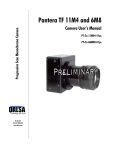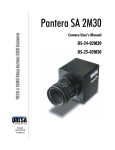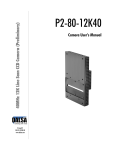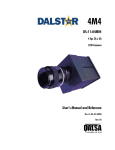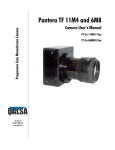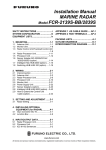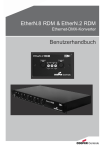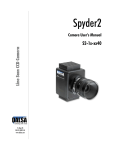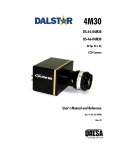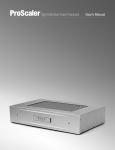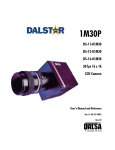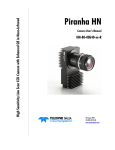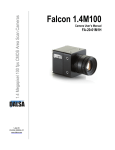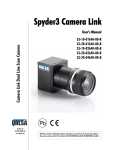Download Dalsa Dalstar DS-41-01M60 User`s manual
Transcript
1K x 1K Progressive Scan Monochrome Camera Pantera 1M60 and 1M30 DS-21-01M60 DS-1A-01M30 DS-22-01M60 DS-1B-01M30 15-Jun-07 03-032-10033-09 www.dalsa.com User’s Manual and Reference 2 Pantera 1M60 and 1M30 User’s Manual © 2007 DALSA. All information provided in this manual is believed to be accurate and reliable. No responsibility is assumed by DALSA for its use. DALSA reserves the right to make changes to this information without notice. Reproduction of this manual in whole or in part, by any means, is prohibited without prior permission having been obtained from DALSA. About DALSA DALSA is an international high performance semiconductor and electronics company that designs, develops, manufactures, and markets digital imaging products and solutions, in addition to providing wafer foundry services. DALSA’s core competencies are in specialized integrated circuit and electronics technology, and highly engineered semiconductor wafer processing. Products include image sensor components; electronic digital cameras; and semiconductor wafer foundry services for use in MEMS, power semiconductors, image sensors and mixed signal CMOS chips. DALSA is a public company listed on the Toronto Stock Exchange under the symbol “DSA”. Based in Waterloo, On. Canada, the company has operations in Bromont, PQ; Colorado Springs, CO; Eindhoven, NL; Munich, Germany and Tokyo, Japan. All DALSA products are manufactured using the latest state-of-the-art equipment to ensure product reliability. All electronic modules and cameras are subjected to a 24 hour burn-in test. For further information not included in this manual, or for information on DALSA’s extensive line of image sensing products, please call: DALSA Sales Offices Waterloo Europe Asia Pacific 605 McMurray Rd Waterloo, ON N2V 2E9 Canada Tel: 519 886 6000 Fax: 519 886 8023 www.dalsa.com [email protected] Breslauer Str. 34 D-82194 Gröbenzell (Munich) Germany Tel: +49 - 8142 – 46770 Fax: +49 - 8142 – 467746 www.dalsa.com [email protected] Space G1 Building, 4F 2-40-2 Ikebukuro Toshima-ku, Tokyo 171-0014 Japan +81 3 5960 6353 (phone) +81 3 5960 6354 (fax) www.dalsa.com [email protected] DALSA Worldwide Operations DALSA Waterloo Colorado Springs Europe Asia Pacific 605 McMurray Rd Waterloo, ON N2V 2E9 Canada Tel: 519 886 6000 Fax: 519 886 8023 www.dalsa.com [email protected] 4820 Centennial Blvd., Suite 115 Colorado Springs, CO 80919 USA Tel: 719 599 7700 Fax: 719 599 7775 www.dalsa.com [email protected] Breslauer Str. 34 D-82194 Gröbenzell (Munich) Germany Tel: +49 - 8142 – 46770 Fax: +49 - 8142 – 467746 www.dalsa.com [email protected] Space G1 Building, 4F 2-40-2 Ikebukuro Toshima-ku, Tokyo 171-0014 Japan +81 3 5960 6353 (phone) +81 3 5960 6354 (fax) www.dalsa.com [email protected] 03-032-10033-09 Pantera 1M60 and 1M30 User’s Manual 3 Contents Introduction to the Pantera 1M60 and 1M30 Area Scan Cameras ______________________ 5 1.1 Camera Highlights.......................................................................................................................................................5 1.2 Image Sensor...............................................................................................................................................................6 1.3 Camera Performance Specifications ............................................................................................................................7 Camera Hardware Interface________________________________________________ 11 2.1 Installation Overview...................................................................................................................................................11 2.2 Input/Output................................................................................................................................................................12 2.3 LED Status Indicator ....................................................................................................................................................12 2.4 Connectors ...................................................................................................................................................................12 2.5 Control Inputs ..............................................................................................................................................................15 Software Interface: How to Control the Camera __________________________________ 17 3.1 Communications Protocol Overview ............................................................................................................................17 3.2 Overview: Setting up the Camera to Send Commands................................................................................................18 3.3 Saving and Restoring Settings.....................................................................................................................................19 3.4 Setting Output Mode (1M60 Only) ..............................................................................................................................19 3.5 Setting the Data Mode.................................................................................................................................................19 3.6 Setting Baud Rate........................................................................................................................................................20 3.7 Setting Frame Rate, Exposure Time, and Exposure Mode...........................................................................................20 3.8 Setting Gains ...............................................................................................................................................................27 3.9 Increasing Sensitivity with Binning..............................................................................................................................28 3.10 Rebooting the Camera...............................................................................................................................................29 3.11 Setting the Pre-trigger ..............................................................................................................................................29 3.12 Setting the Video Mode and Generating Test Patterns .............................................................................................29 Optical and Mechanical Considerations________________________________________ 35 4.1 Mechanical Interface....................................................................................................................................................35 4.2 Lens Mounts.................................................................................................................................................................36 4.3 Mounting the Camera..................................................................................................................................................36 4.4 Thermal Management.................................................................................................................................................36 4.5 Environment ................................................................................................................................................................36 Cleaning and Maintenance ________________________________________________ 37 5.1 Cleaning.......................................................................................................................................................................37 5.2 Maintenance ................................................................................................................................................................38 DALSA 03-032-10033-09 4 Pantera 1M60 and 1M30 User’s Manual Troubleshooting ________________________________________________________ 40 6.1 Common Solutions.......................................................................................................................................................40 6.2 Troubleshooting Using the Serial Interface.................................................................................................................41 6.3 Specific Solutions .........................................................................................................................................................42 6.4 Product Support...........................................................................................................................................................44 Camera Link™ Reference, Timing, and Configuration Table__________________________ 46 B1 All Available Commands ..............................................................................................................................................54 B2 Error Messages .............................................................................................................................................................56 EMC Declaration of Conformity______________________________________________ 58 Manual Revision History __________________________________________________ 59 Index _______________________________________________________________ 61 DALSA 03-032-10033-09 Pantera 1M60 and 1M30 User’s Manual 5 1 Introduction to the Pantera 1M60 and 1M30 Area Scan Cameras 1.1 Camera Highlights Features • 1024 x 1024 resolution, TrueFrame™ CCD architecture • The Pantera 1M60 offers 60 fps, two outputs at full resolution, 40 MHz data rate • The Pantera 1M30 offers 30 fps, one output at full resolution, 40 MHz data rate • 12-bit digitization • High sensitivity with low dark current • Progressive scan readout • Exposure control and antiblooming • Asynchronous image capture, externally triggerable • Tap to tap matching • 100% fill factor • Single 12V to 24V power supply • Multiple triggering options • Four vertical binning modes: 1, 2, 4, and 8 • Four horizontal binning modes: 1, 2, 4, and 8 Programmability • DALSA Simple ASCII protocol controls gain, offset, frame rates, trigger mode, test pattern output, up to 8x8 binning, and camera diagnostics 03-032-10033-09 6 Pantera 1M60 and 1M30 User’s Manual • Serial interface (ASCII, 9600 baud, adjustable to 19200, 57600, 115200), through Camera Link™ Description The Pantera 1M60 and 1M30 digital cameras provide high-sensitivity 12-bit images with a 1k x 1k spatial resolution. The cameras use DALSA’s TrueFrame progressive scan CCDs to simultaneously achieve outstanding resolution and gray scale characteristics. A square pixel format and high fill factor provide superior, quantifiable image quality even at low light levels. Applications The Pantera 1M60 and 1M30 are outstanding performers in fast, very high resolution applications. 12 bit performance provides up to 4096 distinct gray levels—perfect for applications with large interscene light variations. The low-noise, digitized video signal also makes the camera an excellent choice where low contrast images must be captured in challenging applications. Models The Pantera 1M60 and 1M30 cameras are available in these models. Note: If the camera has a non-standard cover glass (e.g. taped) the warranty is void on the CCD. Table 1: Piranha HS-xx Camera Models Overview Model Number Description PT-21-01M60 Programmable 1 or 2 taps, up to 60fps. PT-1A-01M30 1 tap, up to 30fps PT-22-01M60 Programmable 1 or 2 taps, up to 60fps, no glass sensor. PT-1B-01M30 1 tap, up to 30fps, no glass sensor. 1.2 Image Sensor The FTT 1010-M is a monochrome progressive-scan frame-transfer image sensor offering 1K x 1K pixels at up to 60 frames per second. The combination of high speed and a high linear dynamic range (~12 bits at room temperature without cooling) makes this device the perfect solution for high-end real time medical X-ray, scientific, and industrial applications. The Pantera 1M60 offers frame rates at up to 60 frames per second using two output taps to simultaneously read out data. The Pantera 1M30 offers frame rates up to 30 frames per second through a single output tap. The device structure is shown in Figure 1. DALSA 03-032-10033-09 Pantera 1M60 and 1M30 User’s Manual 7 Figure 1: FTT 1010-M Image Sensor 6 black lines 1024 active lines Image Section 20 4 20 1024 active pixels 2060 lines Storage Section Output amplifier (1M60 Only) 6 black lines 1072 cells Output Register Output amplifier 1.3 Camera Performance Specifications Note: All camera performance specifications are referenced to 12-bits. Table 2: Pantera 1M60 and 1M30 Camera Performance Specifications Camera Features Units Resolution H x V pixels 1024 x 1024 Pixel Size µm 12 x 12 Pixel Fill Factor % 100 Output Modes 1M60: Dual or Single 1M30: Single Mechanical Interface Units Size mm Electrical Interface Units Power Dissipation W Input Voltage VDC Power Connector Data Output Format Programming Connector DALSA Notes Notes 94 x 94 x 45 Notes < 15 12 24 6 pin Hirose Bits 12 Base Camera Link™ 03-032-10033-09 8 Pantera 1M60 and 1M30 User’s Manual Optical Interface Units Back Focal Distance M42 Mount mm Notes 6.5mm Lens Mount C or F mount adapters Camera Thread M42x1 Aperture mm 14.34 x 14.34 µm mm ° µm ±400 ± 0.350mm ±1.25 <175 over sensor Sensor Flatness µm 10 peak-peak Camera Performance Units Frame Rate fps Data Rate MHz Sensor Alignment x, y z 0z Parallelism/Tilt Min. Data Format Operating Temp °C Nominal Gain Range Nom. Max. Notes 30 (1M30) 60 (1M60) 2 40 40 8 bit 12 bit 8,10, or 12 bit user selectable. 0 40 At front plate. 1x 4x 1x, 2x, or 4x gain user selectable Dynamic Range dB DN:DN 66 2057:1 Pixel Response NonUniformity (PRNU) %rms <5 FPN %rms <3.8 Random Noise DN rms Sat. Output Amplitude DN DC Offset DN 1.2 1.75 3600 3900 4095 45 50 Antiblooming 1 52 1 >100x 1 1 Responsivity DN/(nJ/cm2) 40@540 nm Power Up Duration sec 10 Regulatory Regulatory Compliance CE Notes: DALSA 1. Nominal output. Light source: broadband quartz halogen, 3200K, 750nm and IR cutoff filter. 2. No binning, full resolution, and Exposure Control disabled. 03-032-10033-09 Pantera 1M60 and 1M30 User’s Manual 9 Test conditions unless otherwise noted: • Pixel Rate: 40 MHz • Exposure Mode 7: 1x1 binning, 1x gain, 60 fps, ECD, internal SYNC, 12 bit • Light Source: Broadband Quartz Halogen, 3250K, with 500-600 nm bandpass filter installed • Ambient test temperature 25°C Figure 2: Pantera 1M60 and 1M30 Responsivity Pantera TF 1M60 and 1M30 Responsivity 48 Responsivity [DN/(nJ/cm2)] 40 32 24 16 8 400 450 500 550 600 650 700 750 800 Wavelength (nm) Figure 3: Typical Normalized Noise vs Ambient Temperature Tap 1 1.2 Tap 2 Normalized Noise (DN) 1.15 1.1 1.05 1 0.95 0.9 0 10 20 30 40 50 Tem perature (°C) DALSA 03-032-10033-09 10 Pantera 1M60 and 1M30 User’s Manual Figure 4: Typical Dark Offset vs Ambient Temperature Tap 1 50.4 Tap 2 Dark Offset Mean (DN) 50.2 50 49.8 49.6 49.4 49.2 0 10 20 30 40 50 Am bient Tem perature (°C) Figure 5: Typical FPN vs Ambient Temperature Tap 1 1.2 Tap 2 Fix Pattern Noise (DN) 1 0.8 0.6 0.4 0.2 0 0 5 10 15 20 25 30 35 40 45 50 Tem perature (°C) DALSA 03-032-10033-09 Pantera 1M60 and 1M30 User’s Manual 11 2 Camera Hardware Interface 2.1 Installation Overview This installation overview assumes you have not installed any system components yet. DALSA In order to set up your camera, you should take these initial steps: 1. Power down all equipment. 2. Following the manufacturer’s instructions, install the framegrabber (if applicable). Be sure to observe all static precautions. 3. Install any necessary imaging software. 4. Before connecting power to the camera, test all power supplies. Ensure that all the correct voltages are present at the camera end of the power cable (The Camera Performance Specifications on page 7 list appropriate voltages). Power supplies must meet the requirements defined in section 2.4 Power Input. 5. Inspect all cables and connectors prior to installation. Do not use damaged cables or connectors or the camera may be damaged. 6. Connect data, serial interface, and power cables. 7. After connecting cables, apply power to the camera. After a few seconds, the status LED on the back of the camera should be green to indicate that the camera is operating and ready to receive commands. 03-032-10033-09 12 Pantera 1M60 and 1M30 User’s Manual 2.2 Input/Output Figure 6: Camera Inputs/Outputs 2.3 LED Status Indicator Table 3: Status LED Color of Status LED Meaning Flashing Green Camera Initialization Solid Green Camera Ready Flashing Red Fatal Error Solid Red Warning, such as firmware did not load or voltage out of limit 2.4 Connectors The camera uses a: • high-density 26-pin MDR26 connector for Camera Link control signals, data signals, and serial communications. Refer to Figure 7: MDR26 Connector for pin descriptions. • 6-pin Hirose connector for power. Refer to section 2.4.2 Power Connector, for pin descriptions. 2.4.1 Camera Link Data Connector The Camera Link interface is implemented as a Base Configuration in the Pantera 1M60 and 1M30 cameras. A Base Configuration uses 1 MDR26 connector and 1 Channel Link chip. The main characteristics of the Base Configuration are: DALSA • Ports supported: A, B, C • Serializer bit width: 28 • Number of chips: 1 • Number of MDR26 connectors: 1 03-032-10033-09 Pantera 1M60 and 1M30 User’s Manual 13 Data Connector Figure 7: MDR26 Connector MDR26 Female 13 1 26 14 M at ing Par t: 3M 334-31 ser ies Cable: 3M 14X 26-SZ LB-X X X -0LC* * Table 4: MDR26 Connector Reference Item Value Pinout BASE 1 GND Item Pinout Value BASE 14 GND 2 X0- 15 X0+ 3 X1- 16 X1+ 4 X2- 17 X2+ 5 Xclk- 18 Xclk+ 6 X3- 19 X3+ 7 SERTC+ 20 SERTC- 8 SERTFG- 21 SERTFG+ 9 CC1- 22 CC1+ 10 CC2+ 23 CC2- 11 CC3- 24 CC3+ 12 CC4+ 25 CC4- 13 GND 26 GND Notes: *Exterior Overshield is connected to the shells of the connectors on both ends. **3M part 14X26-SZLB-XXX-0LC is a complete cable assembly, including connectors. Unused pairs should be terminated in 100 ohms at both ends of the cable. Table 5: DALSA Camera Control Configuration Signal Configuration CC1 EXSYNC CC2 Spare CC3 Spare CC4 Spare Digital Data The camera digitizes internally to 12 bits and has a user selectable output of 8, 10, or 12 bits in LVDS format on the Camera Link connector. You can select the output using the oms command. For details, see section 3.5 Setting the Data Mode. DALSA 03-032-10033-09 14 Pantera 1M60 and 1M30 User’s Manual Data Clocking Signals These signals indicate when data is valid, allowing you to clock the data from the camera to your acquisition system. These signals are part of the Camera Link configuration and you should refer to the DALSA Camera Link Implementation Road Map, available from the DALSA website, for the standard location of these signals: Clocking Signal IMPORTANT: This camera’s data should be sampled on the rising edge of STROBE. Indicates LVAL (high) Outputting valid line DVAL (high) Valid data STROBE (rising edge) Valid data See Appendix A for the complete Camera Link timing, DALSA Camera Link configuration table, and refer to the DALSA Web site for the official Camera Link document. 2.4.2 Power Connector Hirose 6-pin Circular Male 6 1 5 2 4 3 Mat ing Par t: HIRO SE HR10A -7P-6S Pin Description Pin Description 1 +12VDC to +24VDC 4 GND 2 +12VDC to +24VDC 5 GND 3 +12VDC to +24VDC 6 GND The camera requires a single voltage input (+12VDC to +24VDC). The camera meets all performance specifications using standard switching power supplies, although wellregulated linear supplies provide optimum performance. When setting up the camera’s power supplies follow these guidelines: • Protect the camera with a fast-blow fuse between power supply and camera. • Do not use the shield on a multi-conductor cable for ground. • Keep leads as short as possible to reduce voltage drop. • Use high-quality linear supplies to minimize noise. Note: Performance specifications are not guaranteed if your power supply does not meet these requirements WARNING: It is extremely important that you apply the appropriate voltages to your camera. Incorrect voltages will damage the camera. Protect the camera with a fast-blow fuse between power supply and camera. DALSA 03-032-10033-09 Pantera 1M60 and 1M30 User’s Manual 15 Visit the Support area of the DALSA Vision website for a list of companies that make power supplies that meet the camera’s requirements. The companies listed should not be considered the only choices. 2.5 Control Inputs The camera accepts an EXSYNC control input through the Camera Link MDR26F connector. External control signals are optional and enabled through the serial interface. EXSYNC (Triggers Line Readout) EXSYNC is an optional input signal that can be used to trigger the line readout rate. Depending on the camera’s exposure mode setting, it can use either the rising or falling edge of EXSYNC to trigger line readout. Refer to the following table for details. Table 6: EXSYNC Edge Description Mode EXSYNC Edge Description 4 The rising edge of EXSYNC begins camera integration. The falling edge completes integration. 3 The falling edges of EXSYNC define the frame time. 6 The falling edge of EXSYNC initiates camera integration. For more information on camera exposure modes, including timing diagrams, refer to section 3.7 Setting Frame Rate, Exposure Time, and Exposure Mode on page 20. NOTE: EXSYNC should not be clocked faster than the camera’s specified maximum frame rate. The camera ignores the EXSYNC pulse until it has completed reading the last line out. DALSA 03-032-10033-09 16 DALSA Pantera 1M60 and 1M30 User’s Manual 03-032-10033-09 Pantera 1M60 and 1M30 User’s Manual 17 3 Software Interface: How to Control the Camera All camera features can be controlled through the serial interface. The camera can also be used without the serial interface after it has been set up correctly. This chapter explains the most commonly used and important commands, including: i This chapter outlines the more commonly used commands. See Appendix B for a list of all available commands. • Saving and restoring settings, described in section 3.3 Saving and Restoring Settings. • Setting the output mode, described in section 3.4 Setting Output Mode (1M60 Only). • Setting the exposure mode and frame rate, described in section 3.7 Setting Frame Rate, Exposure Time, and Exposure Mode. • Setting gain, described in section 3.8 Setting Gains. The serial interface uses a simple ASCII-based protocol. For a complete list of all available commands, refer to the Communications Protocol in section B1 All Available Commands. Help Command For quick help, the camera can return all available commands and parameters through the serial interface. To generate this list, send the command h to the camera. Retrieving Camera Settings To read current camera settings, send the command gcp. 3.1 Communications Protocol Overview Serial Protocol Defaults: DALSA • 8 data bits • 1 stop bit • No parity • No flow control • 9.6Kbps 03-032-10033-09 18 Pantera 1M60 and 1M30 User’s Manual • Camera does not echo characters When entering commands, remember that: • A carriage return (CR) ends each command. The linefeed character is ignored. • The camera will answer each command with either "OK >" or "Error x: Error Message >". The ">" is always the last character sent by the camera. • The following parameters are used throughout the manual: i = integer f = float t = tap [ ] = optional parameter 3.2 Overview: Setting up the Camera to Send Commands The following steps describe how to begin using the Pantera 1M60 and 1M30 commands. 1. If you have not already set up your camera cables, connect your cables as described in section 2.1 Installation Overview. 2. Using a terminal program (e.g., Microsoft HyperTerminal), open a terminal window. Note: In order to communicate with the camera, a serial connection in the Camera Link cable needs to be established. The framegrabber manufacturers should be able to provide a solution in order to communicate through this serial link. The terminal software can be also provided by the framegrabber manufacturer. Standard terminal software such as HyperTerminal can be used in case if COM port is allocated by the framegrabber. Terminal should be set at 9600 baud during the camera power up. 3. When the terminal window is set up, power on the camera. 4. The boot-up message should appear on the terminal window: Camera Initialization in progress, Please Wait ... OK> You can now communicate with the camera through the terminal using the software commands described in this manual. DALSA 5. Set up the framegrabber to receive the data. Following the framegrabber manufacturer’s instructions, set up the parameters described in the Camera Link™ Configuration Table on page 51. 6. Once the framegrabber is set up for data processing and the camera is powered up, run your image processing software. You should be able to see an image from the camera when exposed to a light source. 7. You can now set the other camera parameters described in this chapter. 03-032-10033-09 Pantera 1M60 and 1M30 User’s Manual 19 3.3 Saving and Restoring Settings The camera provides a number of commands for restoring, storing, and saving settings. • To restore the original factory settings, use the command rfs. • To save all current user settings to EEPROM, use the command wus. The camera will automatically restore the saved user settings when powered up. • To restore the last saved user settings, use the command rus. Figure 8: Saving and Restoring Overview rus Factory Settings User Settings rfs Current Session wus 3.4 Setting Output Mode (1M60 Only) The Pantera 1M60 has two data output taps (or channels). You can configure the camera to read out data using a single tap or you can double your frame rate by simultaneously reading out of both taps. This command is not available in the Pantera 1M30. To select dual or single output mode, use the command: Syntax: sos i Syntax Elements: i 0 Single tap readout, maximum 30 fps 1 Dual tap readout, maximum 60 fps (factory setting) Related Commands: sec Example: sos 0 3.5 Setting the Data Mode The Pantera 1M60 contains two output taps, each are 12 bits. The 24 bits of data (two taps) that are sent from the camera to the frame grabber are divided into three ports: A, B, and C. Each port is 8 bits. The oms command selects the number of bits that the camera sends to the frame grabber from each tap. In the table below, ports A-C refer to the Camera Link specification. The Pantera 1M30 contains one output tap that sends 12 bits of data. DALSA 03-032-10033-09 20 Pantera 1M60 and 1M30 User’s Manual To set the data mode for the camera output, use the command: Syntax: oms i Syntax Elements: i 12 10 8 Notes: • Example: oms 8 12 bit (Factory setting), Tap 1 Data bits 0 to 7 are linked to Port A Tap 1Data bits 8 to 11 are linked to Port B bits 0 to 3 Tap 2 Data bits 8 to 11 are linked to Port B bits 4 to 7 (1M60 only) Tap 2 Data bits 0 to 7 are linked to Port C (1M60 only) 10-bit, Tap 1 Data bits 0 to 7 are linked to Port A Tap 1 Data bits 8 and 9 are linked to Port B bits 0 and 1 Tap 2 Data bits 8 and 9 are linked to Port B bits 4 and 5 (1M60 only) Tap 2 Data bits 0 to 7 are linked to Port C (1M60 only) 8-bit, Tap 1 Data bits 0 to 7 are linked to Port A Tap 2 Data bits 0 to 7 are linked to Port B (1M60 only) To obtain the current output data format, use the command gcp 3.6 Setting Baud Rate To set the speed of the camera serial communication port, use the command: Syntax: sbr i Syntax Elements: i Baud rate. Available baud rates are: 9600 (Default), 19200, 57600, and 115200. Notes: Example: • Power-on rate is always 9600 baud. • The rc (reset camera) command will not reset the camera to the power-on baud rate. sbr 57600 3.7 Setting Frame Rate, Exposure Time, and Exposure Mode With five different exposure mode settings, the Pantera 1M60 and 1M30 deliver many possibilities for flexible camera timing. Table 7 outlines each of these five exposure modes, and is followed by a full explanation on how to set the camera’s frame rate and exposure time. DALSA 03-032-10033-09 Pantera 1M60 and 1M30 User’s Manual 21 Mode Table 7: Overview of Pantera 1M60 and 1M30 Exposure Modes SYNC Exposure Time Exposure Control Notes 2 –Internal –Programmable using the ssf command. –Programmable with set command –Not programmable –Enabled –Maximum frame rate of 57 fps (1M60) The parameter being programmed (i.e. Frame rate or Exposure time) will be the driving factor so that when setting frame rate, exposure time will change to accommodate the new frame rate and visaversa. Factory Setting. 3 –External –Not programmable –Maximum exposure time –Programmable using the sec command Disabling exposure control allows the 1M60 camera to operate at a maximum of 60 fps. When exposure control is enabled, the maximum 1M60 frame rate is 57 fps. 4 –External –Not programmable –Exposure time is the inverse of the frame time –Not programmable –Enabled –Maximum frame rate of 57 fps (1M60) “Smart EXSYNC” Mode: external exposure time – high time of external signal is exposure time and 1/period is frame rate. 5 N/A 6 –External -Programmable with set command –Not programmable –Enabled –Maximum frame rate of 57 fps (1M60) The user is responsible for not violating timing constraints for the external sync signal used in this mode. 7 –Internal –Programmable using the ssf command –Not programmable –Maximum exposure time –Not programmable –Disabled –Maximum frame rate of 60 fps (1M60) Overview: Setting Frame Time and Exposure Time The camera’s frame rate (synchronization) can be generated internally through software commands or input externally from a frame grabber/host system. To select how you want the camera’s frame rate to be generated: DALSA 1. You must first set the camera mode using the sem command. Refer to Step One on the next page for details. 2. If operating in exposure mode 3, use the command sec to enable or disable exposure control. 03-032-10033-09 22 Pantera 1M60 and 1M30 User’s Manual 3. Then, when applicable, use the commands ssf (mode 2 or 7) to set the frame rate and/or set (mode 2 or 6) to set the exposure time. Refer to Step Two on page 25 for details. 3.7.1 Step 1: Setting the Exposure Modes In internal sync modes, (modes 2 and 7), the camera delivers, independent of external signals, data according to the timing set internally. In external sync modes (modes 3, 4, and 6), the camera starts integration after an external trigger pulse. To set the camera exposure mode, use the command: Syntax: sem i Syntax Elements: i Notes: Exposure mode to use. Default is 2. Refer to Table 7 for a quick list of available modes or to the following sections for a more detailed explanation. To obtain the current value of the exposure mode, use the command gcp. Related Commands: ssf, set Example: sem 3 Mode 2: Internally Programmable Frame Rate and Exposure Time When setting the frame rate (using the ssf command), exposure time will change to accommodate the new frame rate. The exposure time will always be set to the maximum time (frame period – frame transfer time – charge reset time) for that frame rate when a new frame rate is entered. Example 1: Exposure Time less than Frame Period FT = Frame Transfer Time CR= Charge Reset FT CR Exposure Time FT CR Exposure Time Programmable Period Readout Readout Frame Period Frame Period Programmable Period Mode 3: External Trigger with Maximum Exposure Frame rate is set by the period of the external trigger pulses. Since there is no electronic shuttering, any trigger pulses faster than the read out time are ignored. The falling edge of the external trigger marks the beginning of the exposure. During the frame transfer state, 1030 lines are transferred down from the sensor’s image area to the storage area (see Figure 1: FTT 1010-M Image Sensor for sensor architecture). If you are operating the camera with exposure control enabled (see page 25 for an explanation on how to disable or enable exposure control), an extra line is transferred to the storage area. While the last line is being transferred, the charge reset also occurs. DALSA 03-032-10033-09 Pantera 1M60 and 1M30 User’s Manual 23 Example 2: Frame Rate is set by External Trigger Pulses. Exposure Time Readout Exposure Time FT CR Frame Period Readout CR FT Frame Period Ignor ed Trigger Trigger Trigger Mode 4: Smart EXSYNC, External Frame Rate and Exposure Time In this mode, the external trigger rate sets both the frame rate and the exposure time. The rising pulse of the external trigger marks the beginning of the exposure and the falling edge ends the exposure and initiates frame transfer. During frame transfer, 1030 lines of data are transferred down from the image area to the storage area of the sensor (see Figure 1: FTT 1010-M Image Sensor for sensor architecture). After the frame transfer had completed, one more line is transferred down and the charge reset occurs, initiating readout. Restrictions: • At the end of the exposure time, the collected data will be transferred to the readout area only if it is not already in the process of reading out. If readout is already in process, the exposure time will be extended until the readout is finished • If the rising edge of the exsync signal occurs during the frame transfer stage, the pulse is moved to the end of the frame transfer. Example 3: Trigger Period is Repetitive and Greater than Read Out Time. 5μs CR FT = Frame Transfer Time Exposure Time FT FT Readout External Trigger CR= Charge Reset Example 4: Trigger Period is Intermittent and Occasionally Shorter than Read Out Time. Exposure Time FT Ignored rising exsync pulse DALSA CR Readout Rising exsync pulse is moved to end of transfer stage Exposure Time FT CR Exposure time is extended to correspond with readout and ignores the falling exsync pulse Readout Ignored falling exsync pulse Falling exsync pulse is moved to end of readout stage 03-032-10033-09 24 Pantera 1M60 and 1M30 User’s Manual Mode 6: External Frame Rate and Internal Exposure Time This mode differs according to the trigger rate and the exposure time setting. However, the following rules apply to any condition: • Any additional external triggers occurring during the exposure time will be ignored. • All non-ignored external triggers will pulse an electronic shutter to dump any current exposure data at the start of the trigger pulse and start the exposure time. • At the end of the exposure time, the collected data will be transferred to the readout area only if it is not already in the process of reading out. If readout is already in process, the exposure time will be extended until the readout is finished, as is illustrated in Example 6. Example 5: Trigger Period is Repetitive and Greater than Read Out Time 5μs Note: The Pantera 1M60 and 1M30 do not use Mode 5. Exposure Time CR FT FT Readout Exposure time set by internal programmable register External Trigger Example 6: Trigger period is Nonreptitive and Occasionally Shorter than Read Out Time Exposure Time Exposure Time Exposure time has been extended to correspond with readout time Programmable Period FT External Trigger DALSA Readout CR External Trigger Ignored Trigger Ignored Trigger 03-032-10033-09 Pantera 1M60 and 1M30 User’s Manual 25 Mode 7: Internal Line Rate, Maximum Exposure Time In this mode, the line rate is set internally with a maximum exposure time. Figure 9: Mode 7 Camera Timing Frame Period Readout FT Frame Period FT ExposureTime Readout ExposureTime 3.7.2 Step 2: Enabling or Disabling Exposure Control (Exposure Mode 3 Only) Camera must be operating in exposure mode 3. Disabling exposure control allows the Pantera 1M60 camera to operate at a maximum of 60 fps. When exposure control is enabled, the maximum Pantera 1M60 frame rate is 57 fps. The frame rate is not affected in the Pantera 1M30 and remains a maximum of 32 fps with exposure mode enabled or disabled. To enable or disable exposure control, use the command: Syntax: sec i Syntax Elements: i Notes: Example: DALSA 0 Exposure control disabled resulting in a frame rate of 60 fps (1M60) or 32 fps (1M30). 1 Exposure control enabled resulting in a frame rate of 57 fps (1M60) or 32 fps (1M30). Exposure control is only programmable when the camera is operating in exposure mode 3. See Table 7: Overview of Pantera 1M60 and 1M30 Exposure Modes for details on which exposure modes operate with exposure control enabled and which operate with exposure mode disabled. sec 1 03-032-10033-09 26 Pantera 1M60 and 1M30 User’s Manual 3.7.3 Step 3: Setting Frame Rate and Exposure Time Setting Frame Rate Camera must be operating in exposure mode 2 or 7. To set the frame rate, use the command: Syntax: ssf i Syntax Elements: i Desired frame rate in Hz. Allowable ranges are (assuming 1x1 binning and dual output in 1M60): Pantera 1M60 • 1-57 Hz if exposure control is enabled • 1-60 Hz if exposure control is disabled Pantera 1M30 • 1-32 Hz if exposure control is enabled or disabled Notes: To read the current line rate frequency, use the command gcp. If you enter an invalid line rate frequency, the valid range of values will be displayed. Exposure control is set using the sec command. See page 25 for details. Related Commands: sec, set Example: ssf 50 Setting Exposure Time Camera must be operating in exposure mode 2 or mode 6. The following table lists exposure mode time limits. Table 8: Exposure Mode Time Ranges Mode Exposure Time Range 2 Fixed by ssf command 6 Limited by current frame rate (EXSYNC frequency) To set the camera exposure time, use the command: Syntax: set f Syntax Elements: f Notes: DALSA Floating point number in µsecs. Allowable range is one line time to 1000000.0 µs. Line times are listed in Table 15 to Table 18 for each camera operating mode. To read the current line rate frequency, use the command gcp. If you enter an invalid exposure time, the valid range of values will be displayed. Related Commands: sem, ssf Example: set 5500.3 03-032-10033-09 Pantera 1M60 and 1M30 User’s Manual 27 3.8 Setting Gains Optimizing gain in the analog domain allows you to achieve a better signal-to-noise ratio (dynamic range) than you would achieve by trying to optimize the gain in the digital domain. As a result, perform all analog gain adjustments (ssg command) prior to any digital gain adjustments (gm command). Setting Analog Gain To set the analog gain, use the command: Syntax: ssg i i Syntax Elements: i Tap value. Either 1 for the left tap or 2 (1M60 only) for the right tap. i 0-4095. 0 corresponds to low gain, 4095 corresponds to high gain Related Commands: gm Example: ssg 1 4000 Setting Digital Gain To set the digital gain, use the command: DALSA Syntax: gm i Syntax Elements: i 0 1x Output Gain Mode (Factory setting) 1 2x Output Gain Mode 2 4x Output Gain Mode Related Commands: ssg Example: gm 2 03-032-10033-09 28 Pantera 1M60 and 1M30 User’s Manual 3.9 Increasing Sensitivity with Binning Binning increases the camera’s light sensitivity by decreasing horizontal and vertical resolution—the charge collected by adjacent pixels is added together. Note: The vertical binning setting directly affects the camera’s sensitivity, readout time and frame rate. The horizontal binning mode affects sensitivity but does not change timing. To set the binning value, use the command: Syntax: sbm i I Syntax Elements: I Horizontal binning value. The valid horizontal binning values include 1, 2, 4, and 8. I Vertical binning value. The valid vertical binning values include 1,2,4, and 8. Available binning modes are 1x1 (factory setting), 1x2, 1x4,1x8,2x1,2x2, 2x4, 2x8, 4x1, 4x2, 4x4, 4x8, 8x1, 8x2, 8x4, or 8x8. Notes: Example: sbm 2 2 Figure 10: 2x2 Binning More charge = brighter pixel q3 q4 q1 + q2 + q3 + q4 q2 q1 2 a a Normal image Binned image 1 Charge in Charge binned: 4 adjacent pixels 1 pixel output Table 9: Pantera 1M30 or 1M60 (Using Single Output) Binning vs. Speed and Exposure Control Disabled Binning (HxV) Read out Time (mS) Frame Rate 1x1, 2x1, 4x1, 8x1 29.987 ms 31.932 fps 1x2, 2x2, 4x2, 8x2 15.654 ms 58.846 fps 1x4, 2x4, 4x4, 8x4 8.5952 ms 100.66 fps 1x8, 2x8, 4x8, 8x8 4.9152 ms 159.89 fps Table 10: Pantera 1M30 or 1M60 (Using Single Output) Binning vs. Speed and Exposure Control Enabled Binning (HxV) Readout Time (ms) Frame Rate 1x1, 2x1, 4x1, 8x1 DALSA 29.978 ms 31.903 fps 03-032-10033-09 Pantera 1M60 and 1M30 User’s Manual 29 1x2, 2x2, 4x2, 8x2 15.654 ms 58.745 fps 1x4, 2x4, 4x4, 8x4 8.5952 ms 100.336 fps 1x8, 2x8, 4x8, 8x8 4.9152 ms 158.949 fps Table 11: Pantera 1M60 Binning vs. Speed using Dual Output and Exposure Control Enabled Binning (HxV) Read out Time (mS) Frame Rate 1x1, 2x1, 4x1, 8x1 16 ms 57.626 fps 1x2, 2x2, 4x2, 8x2 8.614 ms 100.312 fps 1x4, 2x4, 4x4, 8x4 5.017 ms 156.865 fps 1x8, 2x8, 4x8, 8x8 3.1744 ms 220.415 fps Table 12: Pantera 1M60 Binning vs. Speed using Dual Output and Exposure Control Disabled Binning (HxV) Read out Time (mS) Frame Rate 1x1, 2x1, 4x1, 8x1 15.3856 ms 59.792 fps 1x2, 2x2, 4x2, 8x2 8.5112 ms 102.984 fps 1x4, 2x4, 4x4, 8x4 4.941 ms 159.241 fps 1x8, 2x8, 4x8, 8x8 3.136 ms 223.464 fps 3.10 Rebooting the Camera The command rc reboots the camera. The camera starts up with the last saved settings. 3.11 Setting the Pre-trigger A pre-trigger may be required for some frame grabbers. To set the pre-trigger, use the command: Syntax: sp i Syntax Elements: i Pretrigger value from 0 to 15. Example: sp 10 3.12 Setting the Video Mode and Generating Test Patterns To set the video mode, use the command: Syntax: svm i Syntax Elements: i Notes: • Video mode to use. DALSA All modes are available in the 1M60. 03-032-10033-09 30 Pantera 1M60 and 1M30 User’s Manual • Modes 0, 3, 12, and 15 are available in the 1M30 • See table below for mode descriptions Table 13: Pantera 1M60 and 1M30 Video Modes Mode Description 0 Normal operating mode. Available in both the 1M60 and 1M30. Example Image A W 1 Test pattern left side. Available in the 1M60 only. 2 Test pattern right side. Available in the 1M60 only. 3 Test pattern both sides. Available in both the 1M60 and 1M30. 4 Flip image left side. Available in the 1M60 only. W DALSA 5 Flip image left side. Test pattern left side. Available in the 1M60 only. 6 Flip image left side. Test pattern right side. Available in the 1M60 only. 7 Flip image left side. Test pattern both sides. Available in the 1M60 only. 8 Flip image right side. Available in the 1M60 only. 9 Flip image right side. Test pattern left side. Available in the 1M60 only. 10 Flip image right side. Test pattern right side. Available in the 1M60 only. 11 Flip image right side. Test pattern both sides. Available in the 1M60 only. 12 Flip image both sides. Available in both the 1M60 and 1M30. 13 Flip image both sides. Test pattern left side. Available in the 1M60 only. 14 Flip image both sides. Test pattern right side. Available in the 1M60 only. 15 Flip image both sides. Test pattern both sides. Available in both the 1M60 and 1M30. A 03-032-10033-09 Pantera 1M60 and 1M30 User’s Manual 31 Test Patterns Figure 11: 8 Bit Test Pattern (One Output) Figure 12: 10 Bit Test Pattern (One Output) DALSA 03-032-10033-09 32 Pantera 1M60 and 1M30 User’s Manual Figure 13: 12 Bit Test Pattern (One Output) Figure 14: 8 Bit Test Pattern (Two Outputs-1M60 Only) DALSA 03-032-10033-09 Pantera 1M60 and 1M30 User’s Manual 33 Figure 15: 10 Bit Test Pattern (Two Outputs-1M60 Only) Figure 16: 12 Bit Test Pattern (Two Outputs- 1M60 Only) DALSA 03-032-10033-09 34 DALSA Pantera 1M60 and 1M30 User’s Manual 03-032-10033-09 Pantera 1M60 and 1M30 User’s Manual 35 4 Optical and Mechanical Considerations 4.1 Mechanical Interface Figure 17: Housing Dimensions 85.1 46.50±.30 OPTICAL DISTANCE 46.96 1/4-20 x 5mm DEEP 46 5.97±.15 F-MOUNT CONFIGURATION M4 x .7 x 6 DEEP 2x BOTH SIDES 47.0 31.3 17.52±.30 OPTICAL DISTANCE 73.66±.40 36.83±.40 5.51 52.1 IMAGE CENTER (ROTATION WRT CAMERA EDGE IS ±1.25°) 73.66±.40 93.9 50.80±.15 57.9 36.83±.40 46.96±.40 36.8 21.56 93.9 6.56±.30 OPTICAL DISTANCE 10.13 10.13 46.95±.40 M42 x 1 x 4 DEEP M4 x .7 x 6 DEEP 4x C-MOUNT CONFIGURATION DALSA 03-032-10033-09 36 Pantera 1M60 and 1M30 User’s Manual 4.2 Lens Mounts All F-mount adapters have the appropriate back focal distance for the lens type being used. Ensure that the image circle diameter of the lens to be used is as great as the length of the imaging region. The following table provides information regarding the lens mount used and the back focal distance. The M42 lens adapter originated from the high-end photography standard. Distances to its inner flat surface and the outer flat surface are provided. Table 14: Lens Mounts Mount Back Focal Distance (sensor die to adapter) M42 6.56 ± 0.35mm — outer flat surface 4.3 Mounting the Camera The Pantera 1M60 and 1M30 can be mounted via the 3/8” deep, 1/4”-20 threaded tripod mount located on the bottom of the camera. 4.4 Thermal Management For any CCD camera optimal performance is achieved by transferring heat away from the sensor. Keeping a sensor “cool” reduces the amount of dark current generated. Dark current is the leading contributor to FPN, PRNU, dark offset, random noise and other performance specifications, especially when a camera is significantly gained (i.e. +10db). Generally, dark current doubles for every 7°C increase in temperature at the sensor and increases linearly with integration time. The Pantera 1M60 and 1M30 mechanicals have been optimized to transfer heat from the sensor to the front of the housing. Mount fans away from the camera to avoid vibration, and direct the airflow across the housing to decrease the temperature delta between ambient and housing temperatures. Convection is the ideal method to minimize camera warm-up times and reduce dark current generation. Both methods: either conduction through heat sinking, or convection through air flow, greatly reduce dark current and will improve you systems performance. 4.5 Environment The camera and cables should be shielded from environmental noise sources for best operation. The camera should also be kept as cool as possible. The specified operating temperature is 0–40°C measured at the top of the camera. DALSA 03-032-10033-09 Pantera 1M60 and 1M30 User’s Manual 37 5 Cleaning and Maintenance 5.1 Cleaning Electrostatic Discharge and the CCD Sensor Charge-coupled device (CCD) image sensors are metal oxide semiconductor (MOS) devices and are susceptible to damage from electrostatic discharge (ESD). Although many sensor pins have ESD protection circuitry, the ESD protection circuitry in CCDs is typically not as effective as those found in standard CMOS circuits. Electrostatic charge introduced to the sensor window surface can induce charge buildup on the underside of the window that cannot be readily dissipated by the dry nitrogen gas in the sensor package cavity. When charge buildup occurs, surface gated photodiodes (SGPDs) may exhibit higher image lag. Some SGPD sensors may also exhibit a highly non-uniform response when affected by charge build-up, with some pixels displaying a much higher response when the sensor is exposed to uniform illumination. The charge normally dissipates within 24 hours and the sensor returns to normal operation. Preventing ESD Damage To prevent ESD damage, DALSA advises you to take the following handling precautions. 1. Ground yourself prior to handling cameras. 2. Ensure that your ground and your workbench are also properly grounded. Install conductive mats if your ground or workbench is non-conductive. 3. Use bare hands or non-chargeable cotton gloves to handle cameras. NOTE: Rubber fingercots can introduce electrostatic charge if the rubber comes in contact with the sensor window. 4. Do not touch the window, especially in the region over the imaging area. 5. Ground all tools and mechanical components that come in contact with the cameras. 6. DALSA recommends that cameras be handled under ionized air to prevent static charge buildup. The above ESD precautions need to be followed at all times. The rate which electrostatic charge dissipates depends on numerous environmental conditions and DALSA 03-032-10033-09 38 Pantera 1M60 and 1M30 User’s Manual an improper handling procedure that does not appear to be damaging the cameras immediately may cause damage with a change in environmental conditions. Protecting Against Dust, Oil, and Scratches The CCD window is part of the optical path and should be handled like other optical components, with extreme care. Dust can obscure pixels, producing dark patches on the sensor response. Dust is most visible when the illumination is collimated. The dark patches shift position as the angle of illumination changes. Dust is normally not visible when the sensor is positioned at the exit port of an integrating sphere, where the illumination is diffuse. Dust can normally be removed by blowing the window surface using clean, dry, compressed air, unless the dust particles are being held by an electrostatic charge, in which case either an ionized blower or wet cleaning is necessary. Oil is usually introduced during handling. Touching the surface of the window barehanded will leave oily residues. Using rubber fingercots and rubber gloves can prevent contamination. However, the friction between rubber and the window may produce electrostatic charge that may damage the sensor. Improper handling, cleaning or storage of the sensor can cause scratches. Cameras should not be stored in containers where they are not properly secured and can slide against the container. Scratches diffract incident illumination. When exposed to uniform illumination, a camera with a scratched window will normally have brighter pixels adjacent to darker pixels. The location of these pixels will change with the angle of illumination. Cleaning the Sensor Window 1. Use clean, dry, compressed air to blow off loose particles. This step alone is usually sufficient to clean the sensor window. 2. If further cleaning is required, use a lens wiper moistened with alcohol. 3. We recommend using lint free, ESD safe cloth wipers that do not contain particles that can scratch the window. 4. Wipe the window carefully and slowly. 5.2 Maintenance There are no user serviceable parts on this camera. Please contact DALSA service. DALSA 03-032-10033-09 Pantera 1M60 and 1M30 User’s Manual DALSA 39 03-032-10033-09 40 Pantera 1M60 and 1M30 User’s Manual 6 Troubleshooting The information in this chapter can help you solve problems that may occur during the setup of your camera. Remember that the camera is part of the entire acquisition system. You may have to troubleshoot any or all of the following: • power supplies • cabling • frame grabber hardware & software • host computer • light sources • optics • operating environment • encoder Your steps in dealing with a technical problem should be: 1. Try the general and specific solutions listed in sections 6.1, 6.2, and 6.3. 2. If these solutions do not resolve your problem, see section 6.4 on getting product support. 6.1 Common Solutions Connections The first step in troubleshooting is to verify that your camera has all the correct connections. Power Supply Voltages Check for the presence of all voltages at the camera power connector. Verify that all grounds are connected. EXSYNC When the camera is powered on for the first time, the factory setting is exposure mode 2 (no external inputs required). After a user has saved settings, the camera powers up with the saved settings. DALSA 03-032-10033-09 Pantera 1M60 and 1M30 User’s Manual 41 Data Clocking/Output Signals To validate cable integrity, have the camera send out a test pattern and verify it is being properly received. 6.2 Troubleshooting Using the Serial Interface The following commands can aid in debugging. (The complete command protocol is described in Appendix B.) Communications • To quickly verify serial communications send the help command. The h command returns the online help menu. Verify Parameters • To verify the camera setup, send the gcp command. Verify Factory Calibrated Settings • To restore the camera’s factory settings, send the rfs command. • After executing this command send the gcp command to verify the factory settings. Verify Timing and Digital Video Path • Use the test pattern feature to verify the proper timing and connections between the camera and the frame grabber and verify the proper output along the digital processing chain. See below. Generating Test Patterns The camera can generate a test pattern to aid in system debugging. Use the command svm 3 to activate the test pattern. Use the test pattern to verify the proper timing and connections between the camera and the frame grabber. • No test pattern or bad test pattern — May indicate a problem with the camera (e.g. missing bit) or a system setup problem (e.g. frame grabber or timing). Verify the presence of the LVAL and STROBE signals. • Test pattern successful — Run the svm 0 command to deactivate video correction. Verify Temperature • DALSA To check the camera’s internal temperature, use the vt command. If it is within the proper range, the camera returns the temperature of the sensor board and the digitizer. If the temperatures are out of specification, then the camera command returns an out of specification message. 03-032-10033-09 42 Pantera 1M60 and 1M30 User’s Manual LED Status Located on the back of the camera is a status LED used to display the operational status of the camera. Red lights indicate errors or warnings and green lights indicate progress and OKs. Error and warning states are accompanied by corresponding messages further describing current camera status. See section 2.3 LED Status Indicator for the complete LED information. 6.3 Specific Solutions No Output or Erratic Behavior If your camera provides no output or behaves erratically, it may be picking up random noise from long cables acting as antennae. Do not attach wires to unused pins. Verify that the camera is not receiving spurious inputs (e.g. EXSYNC, if camera is in exposure mode that regulates external signals). Line Dropout, Bright Lines, or Incorrect Line Rate Verify that the frequency of the internal sync is set correctly, or when the camera is set to external sync that the EXSYNC signal supplied to the camera does not exceed the camera’s maximum specified line rate. Noisy Output Check your power supply voltage outputs for noise. Noise present on these lines can result in poor video quality. Low quality or non-twisted pair cable can also add noise to the video output. Dark Patches If dark patches appear in your output the optics path may have become contaminated. Clean your lenses and sensor windows with extreme care. 1. Take standard ESD precautions. 2. Wear latex gloves or finger cots 3. Blow off dust using a filtered blow bottle or dry, filtered compressed air. 4. Fold a piece of optical lens cleaning tissue (approx. 3" x 5") to make a square pad that is approximately one finger-width 5. Moisten the pad on one edge with 2-3 drops of clean solvent—either alcohol or acetone. Do not saturate the entire pad with solvent. 6. Wipe across the length of the window in one direction with the moistened end first, followed by the rest of the pad. The dry part of the pad should follow the moistened end. The goal is to prevent solvent from evaporating from the window surface, as this will end up leaving residue and streaking behind. 7. Repeat steps 2-4 using a clean tissue until the entire window has been cleaned. 8. Blow off any adhering fibers or particles using dry, filtered compressed air. DALSA 03-032-10033-09 Pantera 1M60 and 1M30 User’s Manual 43 Horizontal Lines or Patterns in Image A faulty or irregular encoder signal may result in horizontal lines due to exposure time fluctuations; ensure that your exposure time is regular. If you have verified that your exposure time is consistent and patterns of low frequency intensity variations still occur, ensure that you are using a DC or high frequency light source. DALSA 03-032-10033-09 44 Pantera 1M60 and 1M30 User’s Manual 6.4 Product Support If there is a problem with your camera, collect the following data about your application and situation and call your DALSA representative. Note: You may also want to photocopy this page to fax to DALSA. Customer name Organization name Customer phone number fax number Complete Product Model Number (DS-21-01M60, DS-1A-01M30...) Complete Serial Number Your DALSA Agent or Dealer Acquisition System hardware (frame grabber, host computer, light sources, etc.) Acquisition System software (version, OS, etc.) Power supplies and current draw Data rate used Control signals used in your application, and their frequency or state (if applicable) Results when you run the gcp command Detailed description of problem encountered. EXSYNC MCLK PRIN BIN Other _______ please attach description with as much detail as appropriate. If including images, save them in the .tiff format. In addition to your local DALSA representative, you may need to call DALSA Technical Sales Support: Voice: Fax: DALSA North America 519-886-6000 519-886-8023 Europe +49-8142-46770 +49-8142-467746 Asia 519-886-6000 519-886-8023 03-032-10033-09 Pantera 1M60 and 1M30 User’s Manual DALSA 45 03-032-10033-09 46 Pantera 1M60 and 1M30 User’s Manual Appendix A Camera Link™ Reference, Timing, and Configuration Table Camera Link is a communication interface for vision applications. It provides a connectivity standard between cameras and frame grabbers. A standard cable connection will reduce manufacturers’ support time and greatly reduce the level of complexity and time needed for customers to successfully integrate high speed cameras with frame grabbers. This is particularly relevant as signal and data transmissions increase both in complexity and throughput. A standard cable/connector assembly will also enable customers to take advantage of volume pricing, thus reducing costs. The camera link standard is intended to be extremely flexible in order to meet the needs of different camera and frame grabber manufacturers. The DALSA Camera Link Implementation Road Map (available from the DALSA website) details how DALSA standardizes its use of the Camera Link interface. LVDS Technical Description Low Voltage Differential Signaling (LVDS) is a high-speed, low-power general-purpose interface standard. The standard, known as ANSI/TIA/EIA-644, was approved in March 1996. LVDS uses differential signaling, with a nominal signal swing of 350mV differential. The low signal swing decreases rise and fall times to achieve a theoretical maximum transmission rate of 1.923 Gbps into a loss-less medium. The low signal swing also means that the standard is not dependent on a particular supply voltage. LVDS uses currentmode drivers, which limit power consumption. The differential signals are immune to ±1 V common volt noise. Camera Signal Requirements This section provides definitions for the signals used in the Camera Link interface. The standard Camera Link cable provides camera control signals, serial communication, and video data. Video Data The Channel Link technology is integral to the transmission of video data. Image data and image enable signals are transmitted on the Channel Link bus. Four enable signals are defined as: • FVAL—Frame Valid (FVAL) is defined HIGH for valid lines. • LVAL—Line Valid (LVAL) is defined HIGH for valid pixels. DALSA 03-032-10033-09 Pantera 1M60 and 1M30 User’s Manual 47 • DVAL—Data Valid (DVAL) is defined HIGH when data is valid. • Spare— A spare has been defined for future use. All four enable signals must be provided by the camera on each Channel Link chip. All unused data bits must be tied to a known value by the camera. For more information on image data bit allocations, refer to the official Camera Link specification on the http://vfm.dalsa.com Web site. Camera Control Signals Four LVDS pairs are reserved for general-purpose camera control. They are defined as camera inputs and frame grabber outputs. Camera manufacturers can define these signals to meet their needs for a particular product. The signals are: • Camera Control 1 (CC1) • Camera Control 2 (CC2) • Camera Control 3 (CC3) • Camera Control 4 (CC4) Communication Two LVDS pairs have been allocated for asynchronous serial communication to and from the camera and frame grabber. Cameras and frame grabbers should support at least 9600 baud. These signals are • SerTFG—Differential pair with serial communications to the frame grabber. • SerTC—Differential pair with serial communications to the camera. The serial interface will have the following characteristics: one start bit, one stop bit, no parity, and no handshaking. It is recommended that frame grabber manufacturers supply both a user interface and a software application programmming interface (API) for using the asynchronous serial communication port. The user interface will consist of a terminal program with minimal capabilities of sending and receiving a character string and sending a file of bytes. The software API will provide functions to enumerate boards and send or receive a character string. See Appendix B in the Official Camera Link specification on the http://vfm.dalsa.com Web site. Power Power will not be provided on the Camera Link connector. The camera will receive power through a separate cable. Camera manufacturers will define their own power connector, current, and voltage requirements. DALSA 03-032-10033-09 48 Pantera 1M60 and 1M30 User’s Manual Camera Link Video Timing Figure 18: Pantera 1M60 and 1M30 Timing (Input and Output Relationships) STROBE tFRAME PERIOD twSYNC_INT twSYNC IMPORTANT: This camera uses the falling edge of EXSYNC to trigger line readout, unlike previous DALSA cameras, which used the rising edge. EXSYNC tTRANSFER tREADOUT tOVERHEAD FRAME VALID tLF tFL LINE VALID tLINE tLVAL_LOW 1 N DATA DVAL Table 15: 1 Output, ECE Mode of Operation Binning (HxV) Symbol 1x1 2x1 4x1 8x1 twSYNC (min sync pulse, 100 ns 1 2 4 8 x x x x 2 2 2 2 1 2 4 8 x x x x 4 4 4 4 1 2 4 8 x x x x 8 8 8 8 100 ns 100 ns 100 ns 1.3377 ms 1.3377 ms 1.3377 ms 1.3377 ms 1.3377 ms 1.3377 ms 1.3377 ms 1.3377 ms 29.978 ms 15.654 ms 8.5952 ms 4.9152 ms tOVERHEAD (time after readout before next EXSYNC) 1.6 μs 1.6 μs 1.6 μs 1.6 μs TwSYNC_INT (min 29.275 μs 30.575 μs 33.575 μs 38.4 μs TwSYNC_INT (min integration pulse, in SMART SYNC) 29.275μs 30.575 μs 33.2 μs 38.0 μs tFRAME PERIOD 31.344 ms 17.023 ms 9.9665 ms 4.9152 ms 3.075 μs 4.375 μs 6.975 μs 11.8 μs 25.6 μs 25.6 μs 25.6 μs 25.6 μs not SMART SYNC) twSYNC (min sync pulse in SMART SYNC) TTRANSFER (time from falling edge of EXSYNC to start of readout in SMART SYNC, pretrigger=0) TREADOUT (frame readout time, pretrigger=0) integration pulse, not SMART SYNC) (min frame period) tFL (time from FVAL to first LVAL) tLINE (LVAL high time) DALSA 03-032-10033-09 Pantera 1M60 and 1M30 User’s Manual 49 Symbol tLVAL_LOW (LVAL Binning (HxV) 1x1 2x1 4x1 8x1 1 2 4 8 3.675 μs 4.975 μs 7.975 μs 12.8 μs 600 ns 600 ns 1.0 ns 1.0 ns 1 2 4 8 1 2 4 8 1 2 4 8 x x x x 2 2 2 2 1 2 4 8 x x x x 4 4 4 4 1 2 4 8 x x x x 8 8 8 8 low time) tLF (time from last LVAL to end of FVAL) Table 16: 1 Output, ECD Mode of Operation Binning (HxV) Symbol 1x1 2x1 4x1 8x1 twSYNC (min sync pulse, 100 ns x x x x 2 2 2 2 x x x x 4 4 4 4 x x x x 8 8 8 8 100 ns 100 ns 100 ns 1.339 ms 1.339 ms 1.339 ms 1.339 ms 1.339 ms 1.339 ms 1.339 ms 1.339 ms 29.978 ms 15.654 ms 8.5952 ms 4.9152 ms 1.6 μs 1.6 μs 1.6 μs 1.6 μs 29.275 μs 30.575 μs 33.575 μs 38.4 μs TwSYNC_INT (min integration pulse, in SMART SYNC) 29.275 μs 30.575 μs 33.575 μs 38.4 μs tFRAME PERIOD 31.316 ms 16.994 ms 9.9342 ms 6.2542 ms 3.075 μs 4.375 μs 6.975 μs 11.8 μs 25.6 μs 25.6 μs 25.6 μs 25.6 μs 3.675 μs 4.975 μs 7.975 μs 12.8 μs 600 ns 600 ns 1.0 μs 1.0 μs not SMART SYNC) twSYNC (min sync pulse in SMART SYNC) tTRANSFER (time from falling edge of EXSYNC to start of readout in SMART SYNC, pretrigger=0) tREADOUT (frame readout time, pretrigger=0) tOVERHEAD (time after readout before next EXSYNC) TwSYNC_INT (min integration pulse, not SMART SYNC) (min frame period) tFL (time from FVAL to first LVAL) tLINE (LVAL high time) tLVAL_LOW (LVAL low time) tLF (time from last LVAL to end of FVAL) DALSA 03-032-10033-09 50 Pantera 1M60 and 1M30 User’s Manual Table 17: 2 Output, ECE Mode of Operation Binning (HxV) Symbol 1x1 2x1 4x1 8x1 twSYNC (min sync pulse, 100 ns 1 2 4 8 x x x x 2 2 2 2 1 2 4 8 x x x x 4 4 4 4 1 2 4 8 x x x x 8 8 8 8 100 ns 100 ns 100 ns 1.3377 ms 1.3377 ms 1.3377 ms 1.3377 ms 1.3377 ms 1.3377 ms 1.3377 ms 1.3377 ms 16.0 ms 8.614 ms 5.017 ms 3.1744 ms tOVERHEAD (time after readout before next EXSYNC) 1.6 μs 1.6 μs 1.6 μs 1.6 μs TwSYNC_INT (min 15.625 μs 16.825 μs 19.4 μs 24.8 μs TwSYNC_INT (min integration pulse, in SMART SYNC) 15.625 μs 16.825 μs 19.4 μs 24.8 μs tFRAME PERIOD 17.355 ms 9.9689 ms 6.8749 ms 4.5369 ms 2.825 μs 4.025 μs 6.425 μs 11.625 μs 12.8 μs 12.8 μs 12.8 μs 12.8 μs 2.825 μs 4.025 μs 6.8 μs 12.0 μs 0 ns 0 ns 375 ns 375 ns 1 2 4 8 1 2 4 8 1 2 4 8 not SMART SYNC) twSYNC (min sync pulse in SMART SYNC) tTRANSFER (time from falling edge of EXSYNC to start of readout in SMART SYNC, pretrigger=0) tREADOUT (frame readout time, pretrigger=0) integration pulse, not SMART SYNC) (min frame period) tFL (time from FVAL to first LVAL) tLINE (LVAL high time) tLVAL_LOW (LVAL low time) tLF (time from last LVAL to end of FVAL) Table 18: 2 Output, ECD Mode of Operation Binning (HxV) Symbol 1x1 2x1 4x1 8x1 twSYNC (min sync pulse, 100 ns x x x x 2 2 2 2 x x x x 4 4 4 4 x x x x 8 8 8 8 100 ns 100 ns 100 ns 1.339 ms 1.339 ms 1.339 ms not SMART SYNC) twSYNC (min sync pulse 1.339 ms in SMART SYNC) DALSA 03-032-10033-09 Pantera 1M60 and 1M30 User’s Manual 51 Symbol tTRANSFER (time from Binning (HxV) 1x1 2x1 4x1 8x1 1 2 4 8 1.339 ms 1.339 ms 1.339 ms 1.339 ms 15.3856 ms 8.5112 ms 4.941 ms 3.136 ms 1.6 μs 1.6 μs 1.6 μs 1.6 μs 15.025 μs 16.35 μs 19.3 μs 24.5 μs 15.025 μs 16.35 μs 19.3 μs 24.5 μs 16.725 ms 9.7102 ms 6.2798 ms 4.475 ms 2.225 μs 3.55 μs 6.125 μs 11.325 μs 12.8 μs 12.8 μs 12.8 μs 12.8 μs 2.225 μs 3.55 μs 6.5 μs 11.7 μs 0 ns 0 ns 375 ns 375 ns x x x x 2 2 2 2 1 2 4 8 x x x x 4 4 4 4 1 2 4 8 x x x x 8 8 8 8 falling edge of EXSYNC to start of readout in SMART SYNC, pretrigger=0) tREADOUT (frame readout time, pretrigger=0) tOVERHEAD (time after readout before next EXSYNC) TwSYNC_INT (min integration pulse, not SMART SYNC) TwSYNC_INT (min integration pulse, in SMART SYNC) tFRAME PERIOD (min frame period) tFL (time from FVAL to first LVAL) tLINE (LVAL high time) tLVAL_LOW (LVAL low time) tLF (time from last LVAL to end of FVAL) Camera Link™ Configuration Table The following table provides tap reconstruction information. DALSA is working with the machine vision industry to use this table as the basis for auto configuration. Visit the http://vfm.dalsa.com Web site and view the DALSA Camera Link Implementation Road Map document, 03-32-00450, for further details. Pantera 1M60 and 1M30 Interface Parameters Table 19: Frame Grabber Interface Parameters (Unverified) Item (when programmable configuration the options are separated with a | ) DALSA 1M60 1M30 Imager Dimension <1,2 or 1|2> 2 2 Imager Columns<number of active columns, X> 1024 1024 Imager Rows<number of active rows, Y> Line Scan/TDI are defined as 1 1024 1024 Number of Imager Taps 2 1 <1,2,3…..> 03-032-10033-09 52 Pantera 1M60 and 1M30 User’s Manual Item (when programmable configuration the options are separated with a | ) Tap Clock Rate 1M30 <xx MHz> 40 40 Camera Standard <NTSC, PAL, VS, VW, MW> VS VS Variable Window <Column Start, Column End, Row Start, Row End> (0,0,0,0) (0,0,0,0) Multiple Window Number of Windows, (Column Start 1, Column End 1, Row Start 1, Row End 1) (Column Start 2, Column End2, … 0,(0,0,0,0) 0,(0,0,0,0) Camera Color <Hybrid, Mono, Pattern, Solid> Mono Mono Pattern Size <(T1,Columns*Rows)(T2, Columns*Rows)(T3,Columns*Rows….> (T0, 1*1) (T0, 1*1) Color Definition <T1= R,G,B, CY, MG, Y, or M> (T0=(1.1M) (T0=(1.1M) Row Color Offset 0 0 Column Color Offset <0,1,2,3…> <0,1,2,3…> 0 0 Number of Camera Configurations<1,2,3,…> 2 2 Configuration Definition Cx= HDW, Number of Output Taps, Bit Width, Number of Processing Nodes where Cx is the configuration ID x is <1,2,3…> HDW is <Base, Medium, Full> Number of Output Taps is <1,2,3…> Bit width is <8, 10,12…> Number Processing Nodes is <1 or 2> C1 = Base 2,12,1 C1 = Base 1,12,1 CO,T1(1,512,1,1, 1024,1) CO,T2(513,1024, 1,1,1024,1) N/A Tap Reconstruction In some configurations the reconstruction may change. C0 is the default output format and must be listed. Output configurations that don’t conform are listed separately. <Cx,Tn (Column Start, Column End, Column Increment, Row Start, Row End, Row Increment> Row Binning Factor <1,2,3 or 1|2|3> 1|2|4 1|2|4 Column Binning Factor 1|2|4 1|2|4 <1,2,3 or 1|2|3> Pretrigger Pixels <0,1,2…or 0..15> 0..15 (programmable) 0..15 (programmable) Pretrigger Lines <0,1,2.. or 0..15> 0 0 Line/Frame Time Minimum <xx ns> TBD TBD Line/Frame Time Maximum <xx ns> TBD TBD Internal Line/Frame Time Resolution <xx ns> 0 if not applicable N/A N/A Pixel Reset Pulse Minimum Width <xx ns> 0 if not applicable N/A N/A Internal Pixel Reset Time Resolution <xx ns> 0 if not applicable N/A N/A Pixel Reset to Exsync Hold time DALSA 1M60 TBD TBD BAUD Rate <9600….> <xx ns> 9600 9600 CC1 <Exsync> Exsync Exsync 03-032-10033-09 Pantera 1M60 and 1M30 User’s Manual Item (when programmable configuration the options are separated with a | ) DALSA 53 1M60 1M30 CC2 <Spare> Spare Spare CC3 <Forward, Spare> Spare Spare CC4 <Spare> Spare Spare DVAL out <Strobe Valid, Alternate> Tied High Tied High FVAL out <Frame Valid, Alternate> Frame Valid Frame Valid Spare out <Spare> Spare Spare 03-032-10033-09 54 Pantera 1M60 and 1M30 User’s Manual Appendix B Commands and Error Handling B1 All Available Commands This table provides a brief overview of all of the available user commands. For a detailed explanation of these commands, refer to Chapter 3. Parameters: i = integer f = float t = tap DALSA Table 20: All Available Commands Command Syntax Parameters Description gain mode gm get camera model gcm Read the camera model number get camera parameters gcp Read all of the camera parameters. get camera serial gcs Read the camera serial number get camera version gcv Read the firmware version and FPGA version get sensor serial gss Read the sensor serial number help h Display the online help output mode select oms reset camera rc Reset the entire camera (reboot) restore factory settings rfs Restore the camera’s factory settings. restore user settings rus Restore the camera's last saved user settings. set baud rate sbr i i i Sets the digital gain mode. Available values are: 0: 1x output gain 1: 2x output gain 2: 4x output gain Sets the data mode to use. Available values are: 8: 8 bit mode 10: 10 bit mode 12: 12 bit mode Set the speed of camera serial communication port. Baud rates: 9600, 19200, 57600, and 115200. Default baud: 9600 03-032-10033-09 Pantera 1M60 and 1M30 User’s Manual Parameters: i = integer f = float t = tap DALSA 55 Command Syntax Parameters Description set binning mode sbm i i Set the camera’s binning mode. The first value sets the horizontal binning. The second value sets the vertical binning. Available modes are: 1x1, 2x1, 4x1, 8x1, 1x2, 2x2, 4x2, 8x2, 1x4, 2x4, 4x4, 8x4, 1x8, 2x8, 4x8, 8x8. The factory setting value is 1x1. . set exposure control sec i Enables or disables exposure control. Only applicable if you are operating in exposure mode 3. Available values are: 0: Exposure control disabled resulting in a frame rate of 60fps for 1M60 or 30fps for 1M30 1: Exposure control enabled resulting in a frame rate of 57fps for 1M60 or 27fps for 1M30 set exposure mode sem i Set the exposure mode. Available values are: 2: Internal SYNC and PRIN, programmable frame rate and exposure time using commands ssf and set 3: External SYNC, internal PRIN, maximum exposure time 4: Smart EXSYNC 6: External SYNC, internal PRIN, programmable exposure time 7: (Factory Setting) Internal programmable SYNC, maximum exposure time. set exposure time set f Set the exposure time in exposure mode 2 or 6. Value will be a floating point number in µsecs. set output mode sos i Sets whether to read out data using one or two taps. Only applicable to the 1M60. set pretrigger sp i Set the pretrigger to a value from 0 or 15 set sync frequency ssf f Sets the frame rate in modes 2 and 6. set system gain ssg t i The first value is the tap value. Either 1 for the left tap or 2 (1M60 only) for the right tap. The second value is the analog gain with an available range from 0-4095. 03-032-10033-09 56 Parameters: i = integer f = float t = tap Pantera 1M60 and 1M30 User’s Manual Command Syntax Parameters set video mode svm write user settings wus Write all of the user settings to EEROM verify temperature vt Displays the temperature of the digitizer board and the sensor board. Condition <0ºC or >85ºC will produce an error condition. i Description Set video mode. Available values are: 0: Normal operating mode 1: Test pattern Left side (1M60 only) 2: Test pattern Right side (1M60 only) 3: Test pattern Both sides 4: Flip image Left side (1M60 only) 5: Flip image Left side Test pattern Left side (1M60 only) 6: Flip image Left side Test pattern Right side (1M60 only) 7: Flip image Left side Test pattern Both sides (1M60 only) 8: Flip image Right side (1M60 only) 9: Flip image Right side Test pattern Left side (1M60 only) 10:Flip image Right side Test pattern Right side (1M60 only) 11:Flip image Right side Test pattern Both sides (1M60 only) 12:Flip image Both sides 13:Flip image Both sides Test pattern Left side (1M60 only) 14:Flip imgae Both sides Test pattern Right side (1M60 only) 15:Flip image Both sides Test pattern Both sides B2 Error Messages DALSA Code Description Suggested Cause 0 SUCCESS Command executed without major error detected 3 Invalid command Command not recognized 4 Command parameters incorrect or out of range Command parameters are invalid or out of range 03-032-10033-09 Pantera 1M60 and 1M30 User’s Manual DALSA 57 Code Description Suggested Cause 5 Command not available in current exposure mode ssf and set are allowed only in mode 2 (ssf and set) and in mode 6 (set) 11 Unable to configure DSP DSP (FPGA) configuration failure 12 DSP configuration reset failure DSP (FPGA) could not be placed in configuration mode 14 DSP echo test error DISC bus communication test failure 18 External supply voltage is out of specification vv command result 19 The camera's temperature is outside the specified operating range vt command result 23 CRC check failure while attempting to restore the camera settings Camera setting will initialize to default settings, since restore of USER/FACTORY settings failed (internal micro EE memory failure) 24 Camera settings not saved rus, rfs attempted but settings were not saved 03-032-10033-09 58 Pantera 1M60 and 1M30 User’s Manual Appendix C EMC Declaration of Conformity We, DALSA 605 McMurray Rd., Waterloo, ON CANADA N2V 2E9 declare under sole responsibility, that the product(s): DS-21-01M60 DS-1A-01M30 fulfill(s) the requirements of the standard(s) CISPR-22:1997 EMC: EN 50082-1:1997 EN 61000-4-2; +/- 6kV CD, +/-8kV AD:1995 EN 61000-4-3; 3V/m:1995 EN 61000-4-4; 500V, 1100V:1995 EN 61000-4-6; 3V:1996 This product complies with the requirements of the Low Voltage Directive 73/23/EEC and the EMC Directive 89/336/EEC and carries the CE mark accordingly. Place of Issue Date of Issue Name and Signature of authorized person Waterloo, ON, CANADA January 2004 Hank Helmond Quality Manager, DALSA Corp. This Declaration corresponds to EN 45 014. DALSA 03-032-10033-09 Pantera 1M60 and 1M30 User’s Manual 59 Appendix D Manual Revision History The following table summarizes changes made to this manual. The latest manual revisions can be obtained at http://vfm.dalsa.com/docs/docs.asp. Table 20: Manual Revision History DALSA Revision Number Change Description Rev 00 Preliminary manual release Rev 01 Updated the mechanical drawing on page 21 and the camera size spec in Table 2 from 91x91x39 to 93.9 x 93.9 x 41.2. Rev 02 Manual updated to include 1M30, new mechanical drawing, software command updates, new image sensor, and temperature vs performance graphs. Rev 03 Updated dynamic range from 68dB to 66dB, 2600:1 to 2057:1 SAT nom value from 3952 to 3900 Deleted SEE and NEE values. Were incorrect and need to be determined. Updated Table 8 and added Table 9 with new binning vs speed values. Rev 04 Added Pantera branding to manual. Removed "pending" from Regulatory Compliance in spec table and in EMC Declaration of Conformity. Updated Responsivity graph on page 9 from sensor responsivity to camera responsivity. Updated maximum frame rate with exposure control enabled to 57.5fps. Was 57fps. Tables 8 to 11- Binning vs Speed. Values have been updated. Figures 11 to 16- Pictures have been updated. Table 15 to 18, page 46-Camera Link Timing values have been updated. Rev 05 Changed set gain mode command from gnm to gm in section 3.9 and All Available Commands table in Appendix B. Microcode was changed. Rev 06 On page 8, removed the “DC Offset Subtraction” line. Not available in camera. In Specifications table, section 1.3 updated responsivity specification from 24 DN/(nJ/cm2) to 40 DN/(nJ/cm2). Updated Figure 2: Responsivity with same change. Tables 8 to 11- Binning vs Speed. Values have been updated again. Tables 14 to 17, Camera Link Timing, updated with new numbers. Updated Colorado 03-032-10033-09 60 Pantera 1M60 and 1M30 User’s Manual Revision Number Change Description Springs address on page 2. Exposure Mode default changed from 7 to 2. Updated Mode 7 timing diagram on page 22. Was incorrect. Figure 17 (Housing Dimensions) updated to show camera thickness change Rev 07 Change Theta-z (rotational tolerance) in Performance Specification table (pg 7) from 1.0 to 1.25 degrees. Revised 'Rotation WRT Bottom of Camera' in Mechanical Interface drawing on Pg 35 from .6 to 1.25 degrees. Rev 08 Updated sbm command in section 3.9 Increasing Sensitivity with Binning, All Available Commands table in Appendix B, Table 11: Pantera 1M60 Binning vs. Speed using Dual Output and Exposure Control Enabled, , and Table 12: Pantera 1M60 Binning vs. Speed using Dual Output and Exposure Control Disabled. Vertical and horizontal binning factors no longer need to be identical. Rev 09 -Revised sensor alignment, page 8, from ±0.30mm to ±0.350mm. -Updated camera performance specs figures 3 (Typical Normalized Noise vs Ambient Temperature), 4 (Typical Dark Offset vs Temperature), and 5 (Typical FPN vs Temperature), pages 9 and 10. -Reference to the LED on camera back, changed to "status LED." -Revised references to specific pages on the DALSA website. -Changed heading "Online Help" to "Help Command," page 17. -Revised lens mount measurement, page 36, from ±0.3mm to ±0.3mm. -References to "CCDs" in the Preventing ESD Damage section, page 37, changed to "cameras." -Rewrote Verify Temperature section, page 42. -Added "If including images, save them in the .tiff format." to the Product Support section, page 44. -"Preliminary" stamp removed from doc. -Removed "True Frame" references. . DALSA 03-032-10033-09 Pantera 1M60 and 1M30 User’s Manual 61 Index 2 2 taps, 19 A aperture, 8 applications, 6 B baud rate, 20 binning, 28 bright lines, 42 C camera control signals, 47 Camera Link configuration, 13 connector, 13 signals, 14 clock signals, 14 command reference, 54 commands descriptions, 54 compliance, 58 connector, 12 Camera Link, 13 data, 13 pinout, 13 power, 14 D dark patches, 42 data bus, 14 data rate, 8 digital data, 13 DVAL, 14, 47 dynamic range, 8 E EIA-644 Reference, 46 EMC Declaration of Conformity, 51, 58 exposure control, 20 modes, 20 setting, 21 DALSA time, 20 exposure mode setting, 21 exposure time setting, 26 EXSYNC, 15 troubleshooting, 40 external trigger, 15 F features, 5 fill factor, 7 frame rate, 8 setting, 26 FTT 1010-M, 6 FVAL, 46 G gain range, 8 H help, 17 I image sensor, 6 incorrect line rate, 42 inputs, 12 inputs (user bus), 15 installation, 11 interface parameters, 51 L LED, 12 lens M42, 36 mounts, 36 line dropout, 42 LVAL, 14, 46 LVDS, 46 pairs, 47 M MDR26 connector, 12, 13 models, 6 modes, 22 default, 24 03-032-10033-09 62 Pantera 1M60 and 1M30 User’s Manual exposure, 21 operating, 21 operating modes, 22 operating temp, 8 outputs, 12 serial communication reference, 46 serial interface, 17 settings restoring, 19 saving, 19 size, 7 specifications, 7 electro-optical, 8 startup sequence, 18 STROBE, 14 troubleshooting, 41 P T performance specifications, 7 pixel fill factor, 7 size, 7 power dissipation, 7 PRNU, 8 tap reconstruction, 51 taps setting number, 19 Technical Sales Support, 44 temperature, 8 test patterns generating, 41 setting, 30 timing, 48 camera, 48 Camera Link, 48 exposure, 26 mode 7, 25 troubleshooting, 40 N noisy output, 42 O R readout configuring, 19 rebooting, 29 resolution, 7 responsivity, 8 graph, 9 S sensor, 6 alignment, 8 drawing, 7 DALSA V video data, 46 video modes, 30 03-032-10033-09































































